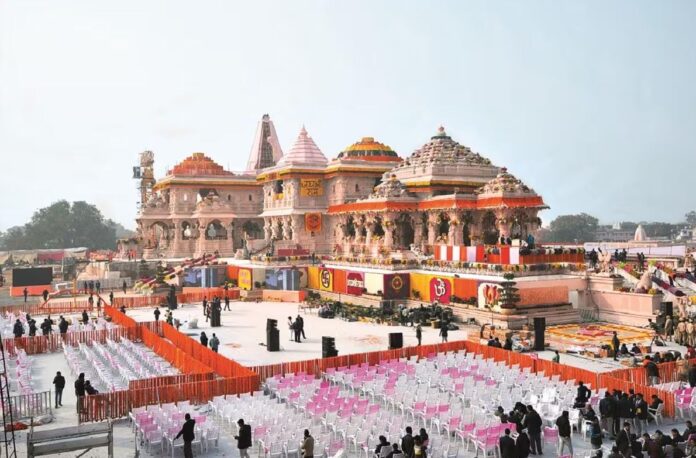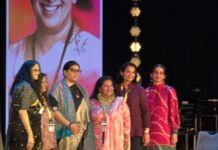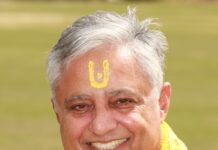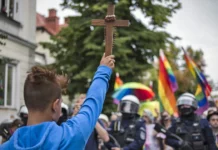Geetha Patil and Sunil Kumar D
Pran Pratishtha ceremony of the new idol of Ram Lalla at the sanctum sanctorum of the Ram Mandir completed with all the Vedic rituals by PM Modi Ji on January 22, 2024 at 12:20 pm.
A long awaited dream of billions of Sanatanis came true and brought immense happiness to them and peace on the earth. The grand temple at Ayodhya for Ram Lalla is truly an amalgamation of traditional Indian architectural heritage and incorporating science for construction so that it can last for centuries. Ram Mandir is a national Mandir and giving a message of blending of North and South Bharat styles to the world.
Shree Ram is not just worshipped in India but is worshipped with all due respect in the Akhand Bharat Desha or Asia. Ramayana is written in different languages of Southeast Asia and Persia. For Bharatiya people, Ram is present in their daily life, they chant his name throughout the day and we also find many people who are called by his various names. Many Bharatiya people knowingly and sometimes unknowingly mention Ram’s name several times in a day. South Bharat’s connection to Ram and Ramayana is special one and is greatly assimilated in Ram Mandir.
How Ram Mandir is unifying entire Bharat
The beautiful Ram Lalla idol that is installed in Ram Mandir is sculpted by Mysuru-based artist Arun Yogiraj and is made of black stone. Both, the sculpture and the stone belong to Karnataka and even the Murti style is related to the South Bharat sculpture style. Ram Mandir has really enhanced the pride of Karnataka People.
There is a great difference between the styles used by the North and South Bharat sculptors. One will see lots of variety in the sculpture styles and beautification of sculptures in South Bharat. When you look at the sculptures of North and South Bharat, you will see Murtis in white marbles in North Bharat while most ancient Mandir Murtis are found in black stones in South Bharat.
The specialty of South Bharat Murtis is that they are not only lovely but lively as well. The beautification of Murtis with intricate ornaments and very elaborate and sophisticated designs on the Prabhavali around the Murtis are mostly done by the South Bharat Sculptors only.
It is near to impossible to describe the distinctive features of Hoysala architecture that displays to the world the skills, beauty, and the patience of the sculptors when they did not have the machines like today. Our Ganga, Kadamba, Chalukya, Pallava, Rashtrakuta, Chola, Hoysala and Vijaya Nagar style temples attract the eyes of the visitors.
There might have been such beautiful temples in North Bharat but the demon invaders might have destroyed them. We now see grand temples only in South. Among all the temples, Hoysala temples have superior architecture. Our Arun Yogiraj has mostly used Karnataka’s Hoysala style in making Ram Lalla Murti.
What are the significant features of Ram Lalla idol?
When you only look at the Prabhavalis of Ram Lalla, Lord Chennakeshvar of Belur, and Veeranarayana, Gadag, Karnataka, you will surely see the similarity of Hoysala style.
The 51 inch tall, Lord Lalla Murti depicts Lord Ram as a five-year-old child. He is called Ram Lalla (Lalla means Child) in North Bharat while he is known as Bala Ram in South Bharat.
The stone used for this idol came from Heggadadevankote, Karnataka. The Hoysala style Prabhavali has 10 Avatars of Lord Vishnu, at the bottom you will see Lord Hanuman Ji. The face of Ram Lalla not only resembles the Badami Chalukya style but also looks more realistic, His costumes are in Chola style, and His ornaments are in Hoysala style.
In most Hoysala style ornaments, we usually see Vaijayanti mala but we do not see it on Ram Lalla Murti.
In the arch of Ram Lalla’s Prabhavali, we see Swastika and Om symbols while in the ancient Hoysala Prabhavali we do not see them. It seems the sculptor; Arun Yogiraj has wisely integrated Hoysala style with North Bharat style. This Ram Lalla Murti is His childhood idol that is before his consecration as king. Therefore, this Murti has no crown on the head. Even though Ram Mandir is built in Nagar style, the main Ram Lalla Murti is in South Bharat Style.
The current temple is built in the North Bharat Nagar Style. In this style, generally temples are huge but not much sculptures and intricate designs. In Maharashtra, we see many Nagar style temples that have incorporated Dravidian style sculptures but not in the up North Bharat temples.
What is the link between South Bharat, Ram and Ramayana?
There is a close relation between South Bharat, Ram and Ramayana. Rama’s ancestors belonged to the Ikshvaku dynasty also called Solar dynasty or Sūryavaṃśa who prayed to the Surya (Sun god) as their prime God hailed from South Bharat and Ram had wheatish skin tone like south Bharat people.
Ikshuvakis Kula Daiva was Ranganatha Swami and was worshipped with utmost devotion by Ma Kausalya. When Ma Sita was kidnapped by King Ravan Lord Ram came to South Baharat and met with Ma Shabari, and came across Vanaras of Kishkinda and with their help, he built bridge between Bharat and Srilanka, killed Ravan and got Ma Sita back to Ayodhya.
When Vibhishan requested Lord Ram to become the king of Srilanka. Lord Ram told him – Janani Janmabhoomi- Swargadapi Gariyasi means “Mother and motherland. are superior to Heaven. Therefore, you become the King of Srilanka. When Vibhishan asked Lord Ram to give him something that reminds him Lord Ram’s presence all the time. Lord Ram gave him a replica of His Kula Daiva, Swami Ranganath’s idol. Vibhishan brought it from Ayodhya and installed it in South Bharat’s Srirangam, Tamil Nadu. This way, Lord Ram’s Kula Daiva is also in South Bharat.
Many people from South Bharat have contributed and are still contributing through their services in building Ram Mandir. Deputy Commissioner-cum-District Magistrate of Faizabad, Mr. K K (Kandangalathil Karunakaran) Nair originating from South Baharat holds a significant place in the annals of the Ayodhya movement and showed courage in restoring the fundamental right to worship for Hindus at the Rama Janmabhoomi even before India attained constitutional republic status.
Archaeologist K K Muhammed was part of the 1976 team that excavated the site where the Ram Mandir in Ayodhya currently stands. He found remains of a temple that was built between 10th and 11th century during the Gurjara-Pratihara Dynasty as evidences of Ram Temple. Sanatanis will never forget the role of K Parasaran, the 91-year-old senior lawyer, who ardently presented arguments for the Hindu side in the Supreme Court’s Ram Mandir case in 2019, opting to do so barefoot and standing for an extended duration. Sri Vishvesha Theertha swami of Pejawar Mutt in Udupi district of Karnataka who was a strong votary of the Ram Janmabhoomi Ayodhya movement and placed Ram Lalla in the tent for worshipping.
Currently, Gopal Nagarkatti, Vishva Hindu Parishad member is working and supervising day and night at the temple site. Even many Places in Karnataka are blessed by Lord Ram’s lotus feet during His journey from Ayodhya to Srilanka. Ma Shabari from Sureban, Belgaum district offered fruits to Lord Ram. Lord Ram halted at Almel village of Vijayapura district, installed a Shiva Ling, and prayed for his success in finding Ma Sita. In Kishkinda (Anegundi, Gangavati district) Lord Ram met with Bali and Sugriva.
Lord Ram also installed Shiva Ling in Byndoor Taluk in the Udupi District. The list goes on and on. In short, Ram Mandir stands as unification of North and South Bharat sculpture styles.







